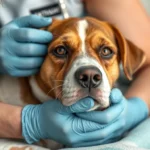
Cherry eye is a condition that can affect dogs, including Cane Corsos, and it occurs when the nictitating membrane, or the third eyelid, prolapses and becomes visible. This condition can be unsightly and may lead to further complications if not addressed promptly. Understanding cherry eye in Cane Corsos is essential for every owner, as it can significantly impact their dog’s health and quality of life.
Understanding Cherry Eye
What is Cherry Eye?
Cherry eye is characterized by the swelling of the gland located in the nictitating membrane. The nictitating membrane plays a crucial role in protecting the eye and keeping it moist. When this gland becomes inflamed or prolapsed, it can appear as a red, fleshy mass in the corner of the eye. For Cane Corsos, this condition can be particularly concerning due to their unique facial structure.
Symptoms of Cherry Eye in Cane Corsos
Recognizing the symptoms of cherry eye is vital for early intervention. Common signs include:
- A noticeable red or pink mass in the inner corner of the eye.
- Excessive tearing or discharge.
- Squinting or rubbing of the eye.
- Signs of discomfort, such as pawing at the eye.
Puppies may exhibit more pronounced symptoms due to their developing immune systems, while adult Cane Corsos may show a more gradual onset of symptoms.
Causes of Cherry Eye
Cherry eye often has a genetic predisposition, meaning that certain breeds, including Cane Corsos, are more prone to this condition. Other contributing factors may include:
- Environmental stressors, such as allergies or irritants.
- Physical trauma to the eye area.
- Inflammation or infection that affects the nictitating membrane.
Understanding these causes can help owners take proactive measures to reduce their dog’s risk.
Diagnosis of Cherry Eye
When to Consult a Veterinarian
If you notice any symptoms of cherry eye in your Cane Corso, it’s crucial to consult a veterinarian promptly. Early detection is key to preventing potential complications, such as chronic inflammation or infection. Signs that warrant a vet visit include:
- Persistent redness or swelling of the eye.
- Changes in behavior, such as increased irritability.
- Difficulty seeing or navigating.
Diagnostic Procedures
A veterinary examination for cherry eye typically includes a thorough physical assessment of the eye and surrounding tissues. The veterinarian may perform several diagnostic procedures, such as:
- A visual examination to assess the position and appearance of the nictitating membrane.
- Fluorescein staining to check for any corneal damage.
- Evaluation for any underlying conditions that may contribute to the eye issue.
These diagnostic steps can help determine the best course of action for treatment.
Treatment Options
Non-Surgical Treatments
In some cases, particularly when cherry eye is caught early, non-surgical treatments may be effective. These can include:
- Topical medications, such as anti-inflammatory drops, to reduce swelling and discomfort.
- Regular cleaning of the eye area to prevent infection.
- Home care strategies, such as using a humidifier to maintain moisture in the air.
However, it’s essential to consult your veterinarian before starting any treatment regimen.
Surgical Treatments
If non-surgical options are ineffective, surgical intervention may be necessary. The most common procedure involves repositioning the gland to restore it to its proper location. This surgical treatment often yields positive results, and most dogs recover quickly. Post-operative care typically includes:
- Administering prescribed medications to manage pain and inflammation.
- Keeping the dog from rubbing or scratching the eye, which may require an Elizabethan collar.
- Regular follow-up appointments to monitor healing and detect any complications early.
Alternative Treatments
Some owners may explore alternative treatments for cherry eye, including holistic approaches like acupuncture or herbal remedies. While some anecdotal evidence supports these treatments, their effectiveness and safety can vary. Always discuss alternative therapies with your veterinarian to ensure they complement traditional treatment methods.
Prevention and Management
Preventive Measures
Preventing cherry eye in Cane Corsos involves several proactive steps:
- Regular veterinary check-ups to monitor eye health.
- Maintaining a clean living environment to minimize allergens and irritants.
- Providing a balanced diet rich in nutrients to support overall health.
By staying vigilant and prioritizing your Cane Corso’s eye health, you can reduce the risk of cherry eye.
Long-Term Management Strategies
If your Cane Corso has a history of cherry eye, long-term management is essential. Caring for a dog with this condition includes:
- Monitoring for signs of recurrence, such as reappearance of the red mass or changes in eye behavior.
- Maintaining a routine of regular veterinary visits to catch any complications early.
- Educating yourself about the condition and resources available for support.
Being proactive in your Cane Corso’s care can lead to successful management of cherry eye.
FAQs from Cane Corso Owners
Common Questions about Cherry Eye
How common is cherry eye in Cane Corsos?
Cherry eye is relatively common in Cane Corsos, especially among younger dogs. Due to their genetic predisposition, owners should be aware of the signs and symptoms.
Can cherry eye lead to other health issues?
If left untreated, cherry eye can lead to complications such as chronic inflammation, corneal damage, or even vision loss. Early intervention is crucial to prevent these outcomes.
Owner Experiences
Many Cane Corso owners have shared their experiences with cherry eye treatment. Anecdotal accounts highlight the importance of acting quickly upon noticing symptoms. Some owners have had success with both surgical and non-surgical treatments, noting that prompt veterinary care often results in positive outcomes. Lessons learned from managing cherry eye stress the importance of vigilance and regular veterinary check-ups.
Conclusion
In summary, understanding cherry eye in Cane Corsos is crucial for ensuring the health and well-being of these beloved pets. By recognizing the symptoms, knowing when to seek veterinary care, and exploring treatment options, owners can take proactive steps to manage this condition effectively. Prioritizing eye health and maintaining regular veterinary visits will help Cane Corso owners stay ahead of potential issues, ensuring their furry friends lead happy, healthy lives. If you suspect your Cane Corso may have cherry eye, don’t hesitate to consult your veterinarian for personalized advice and treatment options.









